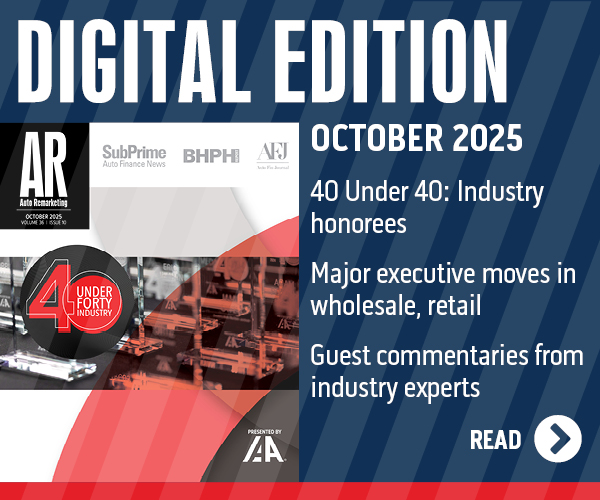Used-car acquisition keys to combat inventory ‘volatility’

Doug Hadden of ACV speaks at Used Car Week 2021. Photo by Jonathan Fredin.
By subscribing, you agree to receive communications from Auto Remarketing and our partners in accordance with our Privacy Policy. We may share your information with select partners and sponsors who may contact you about their products and services. You may unsubscribe at any time.
Ahead of NADA Show 2022, industry leaders and analysts were already discussing the topics that will be covered at the event, such as used-vehicle inventory and prices, as well as new ways dealers are acquiring the quality used vehicles necessary to fill their lots and satisfy their customers.
As for used-vehicle sourcing, dealers have been feeling the impact of tightening used-vehicle inventory levels across physical and digital auctions.
Reflecting the shortage of quality used vehicles last year, KAR Global chief economist Tom Kontos looked at both November and December pricing trends for a recent installment of the Kontos Kommentary and found that wholesale prices closed the year nearly 50% higher than pre-pandemic readings.
The level of auction sales was down, as well. According to a recent Wholesale Market Update from J.D. Power Valuation Services, there were 3.91 million vehicles (up to 8 years old) sold at auction last year — down a significant 13% year-over-year. But the industry must look back to before the COVID 19 pandemic hit to get a full-picture view of the current auction sales environment.
“When compared with pre-pandemic levels, auction sales trended 25%-30% lower during the course of 2021,” J.D. Power said in its analysis.
All of these trends are causing some dealers to turn toward alternative methods of sourcing for used cars to fill their lots.
Subscribe to Auto Remarketing to stay informed and stay ahead.
By subscribing, you agree to receive communications from Auto Remarketing and our partners in accordance with our Privacy Policy. We may share your information with select partners and sponsors who may contact you about their products and services. You may unsubscribe at any time.
In a recent edition of Market Insights from Black Book, the company’s analysts went so far as to say auctions “now seem like a secondary source for inventory.”
Staying ahead of this unusual wholesale environment is key to the success of dealers in 2022. In fact, it could make or break their used-vehicle business.
How to beat ‘inventory volatility’
That’s one of the reasons why Doug Hadden, vice president of field services at digital automotive marketplace and data services company ACV Auctions, is sharing his insights from the wholesale “front lines,” during his session at the NADA Show: ”Stay Ahead of Inventory Volatility.”
This session is part of the new “Dealer Learning Lab” at NADA Show this year. It will be located at booth 1911W. The “lab” offers 20-minute, TED-style talks from presenters in a casual setting on the expo floor.
Hadden began a recent interview with Auto Remarketing by explaining that events that shake the fabric of the country or economy — such as 9/11, Cash for Clunkers, the oil embargo, and of course, the ongoing COVID-19 pandemic — have historically created a ripple effect in the auto industry.
“I mean, anytime anything happens that affects supply, and you still have demand, it just makes things crazy,” Hadden said.
And he contends that even though the aforementioned historical events were impactful for the industry, “ I don’t think ever in history have we seen the values do what they have done during the pandemic — which is grow continuously.”
He explained the speed in which car values have changed and grown is also unprecedented.
Bottom line: “There’s a huge need for vehicles,” Hadden said. “Dealers need vehicles. That’s what they do. If they don’t have vehicles to sell, then they’re basically out of business.”
Hadden pointed out platforms like ACV are working to help dealers navigate the current environment and today’s inventory volatility.
One of the tools ACV provides through its digital marketplace is what Hadden called “Live Appraisal” events, during which the general public can get their vehicle quickly appraised and added to the wholesale vehicle auction stream.
“Dealers can acquire vehicles that way that they couldn’t acquire prior,” Hadden said, noting that the pandemic has also accelerated online buying.
“I don’t think ever before, have we (dealers) looked at acquiring vehicles from consumers like we do today, and I think that’s driven partially by technology and just obviously partially out of the need to find more vehicles,” Hadden said.
Regarding the live appraisal and acquisition events, where ACV is appraising a vehicle at a consumer’s home, “There’s a lot of things that we’re doing that we’re forced to do because of the environment that we’re in today in wholesale.“
As for ACV’s goal, Hadden said: “We need to help our dealer partners figure out how to overcome the lack of inventory and how they can acquire the vehicles that they need to sell.”
When asked how dealers can beat today’s inventory volatility, Hadden boiled it down to one word: data.
“Back in the day, I was a used-car manager for many years … I had a book in my pocket, and I could tell you what a car was worth,” Hadden said.
But the times have changed. “If you don’t use data … it’s not going to go too well,” he said, noting that dealers and used-car managers have to look at values and other data points every day to stay up speed on quickly changing pre-owned vehicle valuations.
Hadden contends dealers also need to — now more than ever — pay attention to the data, and they can use tools like merchandising and sales management platform MAX Digital, for example, to stay competitive.
“Right now, you have some guys that are maybe slacking off a little bit in this area, ” Hadden said, considering the fact that with today’s high demand and low supply, most everything is flying off the lots.
But Hadden warns, “It won’t be this way forever … and you (the dealer) really need to keep track of what you’re doing, what you’re buying … and it’s all based on data.”
Some of the bigger dealer groups are even hiring data scientists for their dealership teams.
Hadden said that during his session, he will be discussing topics that are arising because of this focus on data and data mining — such as AI and machine learning and programmatic business practices. “All the stuff we talk about that seems a little bit futuristic,” but in the long run are helping dealers to be less impacted by volatility in the market, he said.
Hadden’s session is designed to take a “different look” at the ways inventory volatility is addressed today: “What do we do today? How can we get better? … which really boils down to having a process and using technology.”
Technology is so advanced today that dealers often know more about the vehicle at the click of a button than they did kicking tires years ago.
Without giving away too much, Hadden shared he has a few slides to show his session attendees that “they’ll probably get blown away by,” and which explore the future of vehicle condition reports and technology.
The days of guessing on vehicle condition are gone, Hadden said.
Dealers’ role in the shift in used-vehicle sourcing
In light of the aforementioned pre-owned inventory struggles, Randy Kobat, who is VP of operations and inventory management solutions at Cox Automotive, will discuss alternative sourcing methods during his own Dealer Learning Lab session.
Kobat’s session, “How Dealers Reinvented Used Vehicle Acquisition” will take place at booth 1911W.
Granted, vehicle valuations have climbed as of late, but Kobat emphasizes that it’s a “cyclical season … there’s a lot of seasonality that happens here.”
“As we entered the fall, it (values) began to cool off, and then we also began to see it elevate again as we entered into the end of the year, November and December.
But at the beginning of this year, we’ve seen it begin to cool off again,” Kobat told Auto Remarketing, in regards to used pricing. He also noted that as used and new inventory expand, valuations will continue to “cool down” — but we aren’t quite there yet.
That’s thanks in part to the ongoing COVID-19 pandemic, and the actions that have been implemented because of the pandemic, which have had a big impact on the auto industry. For example, Kobat said, “the availability of money and credit was really loosened, which made it easier for many people to buy cars.”
And at the same time, the “lack of new car inventory availability has increased demand for used cars,” he said. Inventory shortages for the microchips that power a lot of electronics in today’s vehicles has “reduced the ability for the car manufacturers to get new-car inventory out into the marketplace,” Kobat said.
Kobat said that despite price hikes and lack of availability from traditional sources — “good inventory has been available.”
Even during these challenging times, dealers have really pivoted to find cars where they are located, Kobat said, in partnership with dealers’ current customer base and vehicle owners experiencing changes due to the pandemic.
But first, dealers and the industry had to tackle the “endowment effect,” a term that’s used in behavioral economics.
“Basically what it means is because I own something, I think it’s worth more than perhaps it really is. And so, we’ve really leveraged some of our most trusted brands to transfer that trust from the brand to our clients’ dealerships, which really helps pave the way to helping the consumer understand and realize what their car is really worth,” he said.
“That’s really helped facilitate more transactions to happen between the consumer and dealership, because of helping them (dealers) manage through the endowment effect and leveraging our (Cox Automotive) brands,” Kobat said.
These alternative sourcing methods in the pipeline for dealers include:
“Consumers that had positive equity position on their loan; Consumers that perhaps had one too many cars now that they were working from home and were in a position to liquidate a car; Consumers coming in for service to get work done on a car that might be a little expensive to repair; Or they were in a positive equity position, and the dealership would approach them on getting into a new car at the same price or less,” Kobat explained, as well as pulling from the usual pool of consumers coming to the end of their lease term.
When asked if the physical auction still has its place in the current pre-owned market, Kobat said, “We’ve seen a significant amount of auction transactions move into a digital environment.”
That said, there are still dealers and car buyers that prefer to see the car in-person before they’re willing to bid on it or buy it off the lot, he said.
“As we’ve prudently and carefully opened our auctions back to have people in person for the auctions, we’ve seen people come back obviously, for that reason, but we think that in the future, we will continue to have a higher percentage of digital transactions in a digital environment,” Kobat said.
“A large percentage of consumers prefer to buy a car from their couch. And we’re facilitating ways to help our clients make that happen on behalf of their buyers and clients,” he added.
As for what Cox Automotive is doing to help dealers navigate this challenging environment, Kobat began by saying, “There’s a lot of things that we’re doing. I think one of the things that I love about our industry is the fact that it’s really powered by entrepreneurs that run these dealerships that have really found new ways to make things happen.
“And we’ve tried to learn from them and then help them facilitate those new ways in an easier fashion,” he said.
For example, Cox has given its dealer clients the ability to send a consumer a link on their smartphone that then leads the consumer to a set of questions that enables the consumer “to really give the dealer good information and value the cars more accurately.”
So, whether it’s providing an easier way for dealers and their shoppers to communicate through the vehicle trade-in process or perfecting a digital retailing platform that our clients can use to “create a real true ecommerce experience for the consumers,” Cox Automotive is expanding options for dealers to use technology to make a difficult environment easier to navigate.
As far as what Kobat will be covering in his upcoming session at the NADA Show, he said that the Dealer Learning Lab will focus on all the different ways that are available to dealers to acquire cars — looking at every different channel of acquisitions — and how to improve processes in all of those areas.
“There are a variety of good quality cars available to the dealership to stock their lots with, even in these challenging times,” he said. “I respect and in many ways am in awe of how these entrepreneurs that run their dealerships are responding to the difficult environment and how it relates to my background and experience and growing up in a family of entrepreneurs … you know, really responding to trying times with a lot of grit, and how partners and trusted brands can really help your business survive and thrive in challenging times, as well.”


